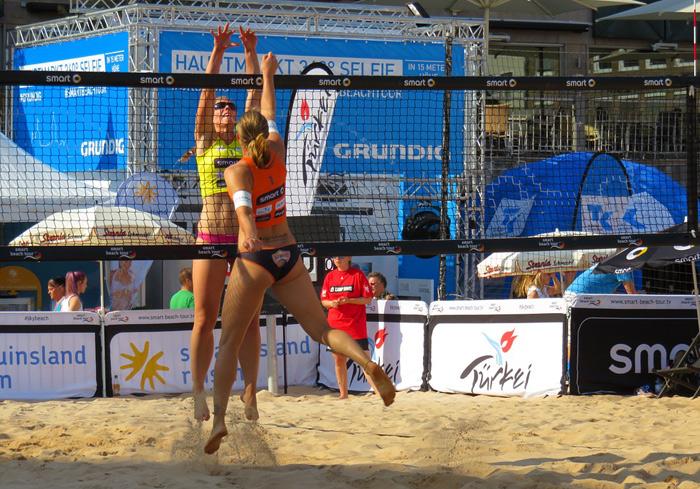In addition to the high level of skill required to play volleyball, to be successful you need, among other things, good speed, power and agility! However, which of these are more important? Below is a discussion about the fitness requirements for volleyball, which can help with developing training programs for this sport, and for interpreting fitness testing results and determining the relative strengths and weaknesses of a player.
 beach volleyball game
beach volleyball gameYou Need Speed, Power and Agility
We have a poll about the component of fitness most important for success in volleyball. Out of the options of Body Size and Composition, Muscle Strength, Muscular Endurance, Power, Speed / Quickness, Agility, Flexibility, Balance and Coordination, and Cardiovascular Endurance, the factors which are considered most important by the readers of this site are power, agility, speed and balance /coordination. You can add your vote too, and see the latest results.
You need to be skillful, with good coordination, agility, reaction time and speed
In a similar poll, we have asked people to rate the 12 factors of success for sports. Visitors to this site have rated each of these factors for the sport of indoor volleyball, and the most important according to them are: skill, balance/coordination, agility, reaction time and speed/quickness. You can also add your ratings of Which Factors Make Successful Indoor Volleyball Players, and see the latest results.
For comparison, we have asked the same questions for beach volleyball athletes. Although it is only preliminary data, beach volleyball wins out on many of the factors compared to indoor volleyball. The factors considered more important for the beach version are body size and composition, aerobic endurance, speed and reaction time. See the Indoor v Beach Volleyball comparison.
Most Important Factors for Success in Order of Importance (data from 2018)
4.2 Skill and Technique
4.1 Balance & Coordination
4.0 Agility
4.0 Reaction Time
4.0 Speed / Quickness
4.0 Motivation & Self Confidence
3.9 Strength & Power
3.9 Coping with Pressure Situations
3.8 Analytic & Tactical Ability
3.5 Flexibility
3.3 Aerobic Endurance
3.2 Body Size and Composition


 Upcoming Events
Upcoming Events